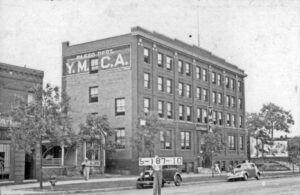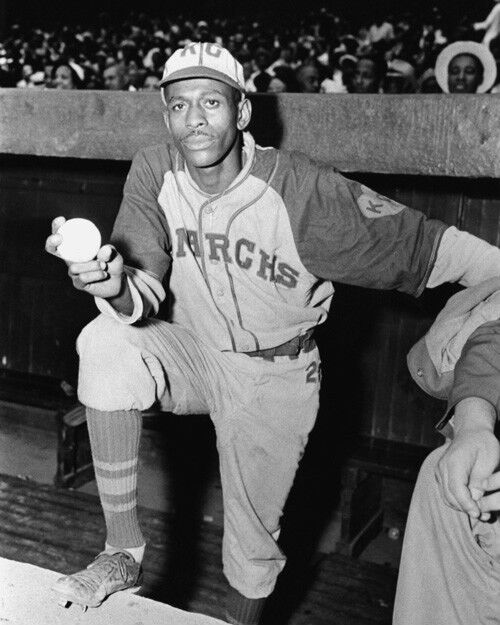Negro National League: 1920-1931
Independent: 1932-1936
Negro American League: 1937-1961
Independent: 1962-1965
Tombstone
Born: February 13, 1920 (Negro National League founding franchise)
Folded: 1965
First Game: May,1920
Last Game: September, 1965
League Titles: 12
Negro World Series Championships: 2 (1924, 1932)
Stadium
Association Field: 1920-1923
Opened: 1903
Demolished: 1925
Kansas City Municipal Stadium: 1924-1955
Opened July 3, 1923
Demolished: April 1976
Valley Field (Grand Rapids, MI): 1956-1965
Opened: 1937
Renamed: 1996 (Sullivan Field)
Ownership
Owners:
J.L. Wilkinson, 1920-1947
Tom Baird: 1947-1956
Ted Rasberry: 1956-1965
Background
The Kansas City Monarchs are easily the most famous Negro League baseball team of all time. Following the integration of the Major Leagues in 1947, the Monarchs sent more players to the American and National leagues than any of their contemporaries. Stars like James “Cool Papa” Bell, Turkey Stearnes, Satchel Paige, Newt Allen, Jesse Williams, Bonnie Serrell, Wilber Rogan, Buck O’Neil, and, of course, Jackie Robinson, the man who broke the color barrier, all played for the Monarchs at one time.
Our Favorite Gear
Kansas City Monarchs NLB Apparel
When it comes to replica jerseys, we turn to our friends at Royal Retros, who put extraordinary detail into their fully customizable baseball jerseys, including those for the Kansas City Monarchs.
Free Customization Included
Each jersey individually handmade
Any name and number
Sewn tackle twill crest, numbers & letters
100% polyester
Heavyweight fabric made to game standards
Honor the memory of the iconic Kansas City Monarchs in great apparel from Royal Retros
Even after integration, the team played until 1965, finishing its existence as a barnstorming team based in Grand Rapids, Michigan, but still using the full Kansas City Monarchs name.
Before the Monarchs
Kansas City’s first uniformed, organized, Black baseball team was fielded in 1897 and was called Wall’s Laundry Grays. They were sponsored, as the nickname suggests, by a local laundry business. They were soon joined by another team. That club was sponsored by a local music shop called Jenkins Music Company. However, Mr. Jenkins withdrew sponsorship when the team started playing games on Sundays, which went against his Methodist beliefs.
After finding a new sponsor, they became known as the Kansas City Monarchs. In 1915, a third team emerged when the All Nations club, originally based in Des Moines, IA, moved to Kanas City.
The All Nations team was established by J. Leslie Wilkinson, better known as Wilkie to friends and family and later known as J,J. The name of the club was inspired by their diverse roster, which included whites (like Wilkinson), blacks, Cubans, Native Americans, Mexicans, and a woman who played second base billed as Carrie Nation. Over in Kansas City, KS was a team called the Kansas City Giants.
World War I wiped out the area’s Black teams. However, in 1920, Rube Foster, founder and manager of the Chicago American Giants, spearheaded an effort to establish the first organized league of Negro teams. Where previous efforts over the past 15 years had failed, Foster found success.

The Legend Begins
On February 13, 1920, at Kansas City’s Paseo YMCA, the Negro National League (NNL) was founded. The Chicago American Giants were joined by another Chicago team called simply the Chicago Giants, as well as the Detroit Stars, the Dayton Marcos, the Indianapolis ABC’s, the St. Louis Giants, and the Kansas City Monarchs, represented by Wilkinson, the league’s only white team owner. At first, Foster sought a group of black businessmen to take the Kansas City franchise, but unable to find any suitable candidates, he decided to work with Wilkinson, who had a favorable relationship with the folks who ran Association Park, the city’s premiere ballfield. Association Park was also home to the American Association’s Kansas City Blues.
Area fans quickly made a distinction between the new NNL squad and the previous team that used the nickname. The older club came to be referred to as the Original Monarchs.
Wilkinson decided to stay in the background. He brought Dr. Howard Smith and local businessman Quincy J. Gilmore to be the public faces of the team at games and other public events. The duo often represented the team at league meetings. Gilmore was, officially, the traveling secretary.
Dominating the League
The Monarchs put together a solid club and finished with 44 wins, 33 losses, and two ties in their inaugural season. Unfortunately, that was good only for second place as the Chicago American Giants captured the 1920 NNL pennant. It was the same in 1921 as the American Giants claimed the top spot again.
In 1922, the Monarchs finally won the pennant, edging out the Indianapolis ABC’s by virtue of a better winning percentage. Often, NNL clubs played teams that were not league members. These were called association teams, but games against them counted in the NNL standings. As such, the standings showed a different number of games played by the league’s eight clubs. In 1923, the Monarchs left no doubt as they finished three and a half games ahead of the American Giants to win that year’s pennant.
That same season saw the debut of the Eastern Colored League, officially the Mutual Association of Eastern Colored Clubs. Two of that league’s clubs, the Hilldale Club of Philadelphia and the Bacharach Giants of Atlantic City, had been associate members of the NNL but had decided to form a new league with other East Coast-based clubs.
World Champions
Fans soon hoped for a championship series between the two, similar to Major League Baseball’s World Series. In 1924, their wish was granted as the NNL pennant winners, the Monarchs, met the Hilldale Club in the first Negro World Series. The Monarchs triumphed five games to four, with one tie.
In 1925, a championship series was introduced in the NNL that pitted the first and second-place teams against each other for the right to face the ECL champion in the World Series. The Monarchs won the pennant in 1925 and downed the St. Louis Stars four games to three. However, they lost the World Series to the Hilldale Club.
A New League
The NNL lasted until 1931, when it succumbed to the economic stresses of the Great Depression. The ECL had folded three years earlier. A second Negro National League was formed in 1933, but the Monarchs did not join that circuit. Instead, they continued as a barnstorming team before joining the Negro American League (NAL) as a charter member in 1937.
The Monarchs dominated the NAL. The team won six pennants between 1937 and 1948. In 1949, the NAL was designated a minor league as Major League Baseball was finally integrated. The Monarchs, though, like many of the NAL’s pre-desegregation teams, played on. Kansas City captured another pennant in 1953.
The End in Kansas City
In 1954, the Philadelphia Athletics moved to Kansas City and became the Monarch’s stadiummates. Previously, they had shared the facility with the minor league Blues, but the major league team’s schedule was more demanding, which led to less favorable dates for the Monarchs. In 1955, the team was sold to entrepreneur Ted Rasberry, who moved the team to Grand Rapids but kept the Kansas City Monarchs name. They remained members of the NAL until the league folded at the end of the 1962 season. For the next three seasons, the Monarchs were a barnstorming club and toured the U.S. and Canada. Raspberry finally pulled the plug in the fall of 1965.
A month later, baseball impresario and Kansas A’s owner Charlie O. Finley signed Monarchs legend Satchel Paige to a contract. It was done partly as a publicity stunt, as the A’s were 57-96 and dead last in attendance the day Paige was scheduled to pitch. The contract also helped him qualify for a Major League Baseball pension. He started the September 25 game against the Boston Red Sox. Apparently, no one told Paige he could take it easy as he went three shutout innings, allowing just one hit and striking out a batter to the delight of the nearly 9,300 fans in attendance.
Our friends at the Good Seats Still Available podcast did an episode on the Kansas City Monarchs and J.L. Wilkinson:


